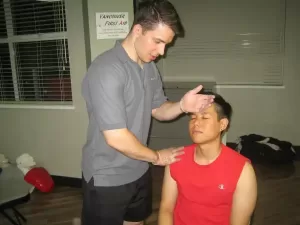Register for a Course
Learn to save a life by learning basic cardiopulmonary resuscitation (CPR) and automated external defibrillator (AED) skills. Be prepared for almost any situation by taking a combined first aid and CPR program. We provide a wide range of basic first aid courses such as standard, emergency and childcare first aid. These courses meet government, academic and workplace requirements. Certificates are valid for 3 years.

Easy Registration
All of our training partners are passionate about providing high quality training programs at incredibly competitive prices. They also provide a variety of registration methods including telephone, email and on-line registration. You can even register for a course through this website. You can select your location from the menu above or visit our location page to see where all of our providers are located in Canada. All providers meet or exceed our high quality standards.

Contact Us
We have friendly and welcoming customer support staff that can help answer any of your questions. They can also help with registration or to book a private class for almost any size with almost any course. We believe our great customer service can help get you into the right class at the perfect location.

Basic first aid training equips individuals to handle almost any emergency situation. In Canada, cardiovascular diseases, including heart attacks, cardiac arrest, and strokes, are the leading causes of death. By learning first aid, CPR, and how to use an automated external defibrillator (AED), you can significantly improve the chances of survival for victims of cardiovascular emergencies.
Different Providers
Canadians have the option of selecting from a number of first aid and CPR providers to take a course with. Most of our providers meet government legislation for first aid and CPR courses. The following is a list of the top 4 providers:
- St Mark James Training
- Vancouver First Aid
- The Heart and Stroke Foundation of Canada
- St. Johns Ambulance
Different Levels of Basic First Aid and CPR

The providers listed above offer a variety of different basic first aid and CPR courses. All first aid courses include training and certification in CPR and AED’s. The following is a list of courses that are offered by all 4 mentioned providers:
- Emergency First Aid, CPR level “A” and AED.
- Standard First Aid, CPR level “C” and AED.
- Standard First Aid, health care provider CPR (CPR HCP), and AED.
These course are the most popular first aid courses available to Canadians. Some providers, such as St Mark James offer other first aid courses that meet legislation standards. The following is a list of courses offered through St Mark James:
- Emergency Childcare First Aid, CPR level “B” and AED.
- Standard Childcare First Aid, CPR level “B” and AED.
- WorkSafeBC approved occupational first aid level 1.
St Mark James also offers Babysitting first aid courses which do not meet any legislation standards.
Different Levels of Basic CPR Training
When registering for a basic first aid course candidates can have the option of selecting the level of CPR training. The following is a list of the different levels of CPR training:
- CPR level “A” and AED.
- CPR level “B” and AED.
- CPR level “C” and AED.
- Health Care Provider CPR (CPR HCP) and AED.
All of the major providers offer these CPR courses.
Certification
Upon successful completion of the basic first aid and or CPR courses candidates will receive either a wallet sized certificate, wall mount certificate or both. Most providers and training partners give candidates the opportunity to select either or both of the awards. All of the providers give certification that is valid for 3 years and awards that are nationally accredited and valid throughout Canada. Awards are not valid internationally.
The Importance of Having First Aid Training
Basic first aid training is an essential skill everyone should have. Accidents can occur anywhere—at home, work, school, or in public spaces—and having a trained first aider nearby can make all the difference. In life-threatening situations, individuals who know first aid can save lives while waiting for professional help to arrive. First aid knowledge is so vital that even elementary school children are being taught these critical skills, enabling them to assist injured individuals or themselves when immediate help isn’t available.
During accidents, people often panic, which can worsen the situation, especially when the victim is vulnerable. First aid courses teach individuals how to stay calm, assess the situation quickly, and prevent further harm to the injured. Equipped with these skills, first aiders can ensure the safety of others and provide effective care when it’s most needed. It’s clear that first aid training is not just important, but lifesaving.